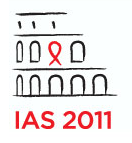Hormonal contraception and HIV transmission risk
1 August 2011. Related: Conference reports, Pregnancy, IAS 6th Rome 2011.
 Polly Clayden, HIV i-Base
Polly Clayden, HIV i-Base
Some epidemiological and laboratory studies have suggested that hormonal contraception can increase HIV transmission risk in women. There has been little research into the risk of transmission from women to men. To date findings have been inconsistent and WHO has called for high quality studies to look at potential interactions between hormonal contraception and HIV transmission.
Investigators from The Partners in Prevention HSV/HIV Transmission Study compared HIV incidence among women using hormonal contraception to those who were not. This analysis evaluated both HIV acquisition among women and transmission from women to men. Renee Heffron presented findings from this study in an oral presentation at IAS 2011. [1]
This was a prospective cohort study of 3790 serodiscordant couples from seven countries in East and southern Africa. The couples were enrolled from two studies conducted between 2004 and 2010, a randomised trial of acyclovir to reduce HIV transmission (n=3321) and a prospective cohort study of immune correlates of HIV protection (n=469).
Study participants were 18 years of age or older, and at enrollment the HIV-positive partners were not eligible for ART according to national guidelines. HIV-negative partners were tested quarterly and HIV-positive partners had CD4 measurements every six months and plasma and genital viral load at enrollment and six months later. The investigators used standardised questionnaires to measure sexual behaviour and contraceptive use.
They compared rates of HIV acquisition in women and HIV transmission from women to men using multivariate Cox proportional hazards regression and marginal structural modeling. The analyses were limited to infections acquired from the study partner (evaluated by viral genetic sequencing).
The negative partners were women in about a third (n=1314) of the couples evaluated, and two thirds (n=2476) were men.
Among the negative women, 21.2% overall used hormonal contraception at least once during follow up, of which 16% used injectable contraception at least once and 6.7% oral contraception. The HIV acquisition rates were 6.61 and 3.78 per 100 person-years in women currently using and not using hormonal contraception [AHR 1.98; 95%CI 1.06-3.68. p=0.03]. For injectable contraception the incidence rate was 6.85 per 100 person-years [AHR 2.05; 95%CI 1.06-3.68, p=0.04] and for oral contraception it was 5.94 per 100 person-years, [AHR 1.8 95%CI 0.55-5.82, p=0.33].
Overall, 33.3% of HIV-positive partners of negative men used hormonal contraception, 26.8% injectable and 8.9% oral. In these couples, HIV transmission rates from women to men were 2.61 and 1.51 per 100 person-years in those whose partners used and did not use hormonal contraception [AHR 1.91, 95%CI 1.12-3.45, p=0.02]. For injectable contraception the incidence rate was 2.64 per 100 patient years [AHR 1.95; 95%CI 1.06-3.58, p=0.03]. The incidence also increased in the group using oral contraception, 2.50 per 100 patient years, but as with HIV acquisition in negative women this did not reach statistical significance in this subgroup [AHR 2.09; 95%CI 0.75-5.84, p=0.16].
Results from marginal structural model analyses were consistent with those shown from the Cox proportional hazards regression.
When the investigators looked at this a possible explanation, there were significantly higher genital viral load concentrations overall in women using hormonal contraception [OR 1.51; 95%CI 1.13-2.01, p=0.01]. For injectable contraception these were significantly higher [OR 1.67; 95%CI 1.21-2.31, p=0.02]. But not for oral contraception [OR 1.06; 95%CI 0.62-1.84, p=0.49].
Dr Heffron noted that this was the first study to demonstrate that hormonal contraception increased an HIV-positive womans risk of transmitting HIV to her partner.
She added that the benefits of effective hormonal contraception are unequivocal and must be balanced with the increase in risk of HIV infection. These possible risks should be discussed with women and couples alongside the importance of HIV prevention.
Strategies to improve access to and usage of lower dose and non-hormonal methods IUDs, implants, patches or combination injectables are warranted she concluded.
comment
These findings understandably caused quite a stir and urgently need more investigation. This was followed by the report from Partners in Prevention that pregnancy doubles the risk of transmission from HIV-positive women to her male partner (to be reviewed in the next issue of HTB). [2]
References
- Heffron R et al. Hormonal contraceptive use and risk of HIV-1 transmission: a prospective cohort analysis. 6th IAS Conference on HIV pathogenesis, treatment and prevention. 17-20 July 2011. Rome, Italy. Oral abstract WEAX0206. Webcast.
- Mulago NR et al. Increased risk of HIV-1 transmission in pregnancy: a prospective study among African HIV-1 serodiscordant couples. Advance online edition of AIDS 25, doi: 10.1097/QAD.0b013e32834a9338, 2011.

